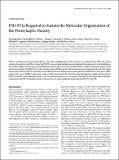PSD-95 Is Required to Sustain the Molecular Organization of the Postsynaptic Density
Author(s)
Chen, Xiaobing; Nelson, Christopher D.; Li, Xiang; Winters, Christine A.; Azzam, Rita; Sousa, Alioscka A.; Leapman, Richard D.; Gainer, Harold; Sheng, Morgan Hwa-Tze; Reese, Thomas S.; ... Show more Show less
DownloadChen-April 2011-PSD-95 Is Required t.pdf (3.009Mb)
PUBLISHER_POLICY
Publisher Policy
Article is made available in accordance with the publisher's policy and may be subject to US copyright law. Please refer to the publisher's site for terms of use.
Terms of use
Metadata
Show full item recordAbstract
PSD-95, a membrane-associated guanylate kinase, is the major scaffolding protein in the excitatory postsynaptic density (PSD) and a potent regulator of synaptic strength. Here we show that PSD-95 is in an extended configuration and positioned into regular arrays of vertical filaments that contact both glutamate receptors and orthogonal horizontal elements layered deep inside the PSD in rat hippocampal spine synapses. RNA interference knockdown of PSD-95 leads to loss of entire patches of PSD material, and electron microscopy tomography shows that the patchy loss correlates with loss of PSD-95-containing vertical filaments, horizontal elements associated with the vertical filaments, and putative AMPA receptor-type, but not NMDA receptor-type, structures. These observations show that the orthogonal molecular scaffold constructed from PSD-95-containing vertical filaments and their associated horizontal elements is essential for sustaining the three-dimensional molecular organization of the PSD. Our findings provide a structural basis for understanding the functional role of PSD-95 at the PSD.
Date issued
2011-03Department
Massachusetts Institute of Technology. Department of Brain and Cognitive Sciences; Picower Institute for Learning and MemoryJournal
Journal of Neuroscience
Publisher
Society for Neuroscience
Citation
Chen, X. et al. “PSD-95 Is Required to Sustain the Molecular Organization of the Postsynaptic Density.” Journal of Neuroscience 31 (2011): 6329-6338.
Version: Final published version
ISSN
0270-6474
1529-2401